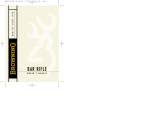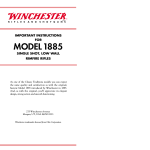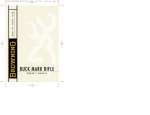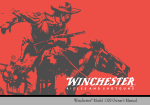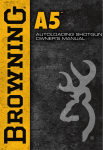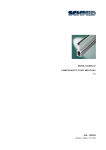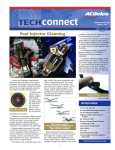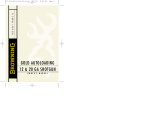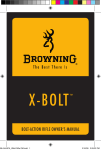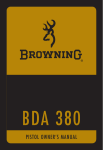Download BAR SHORTTRAC/ LONGTRAC RIFLE
Transcript
6/18/04 11:46 AM The Best There Is ® 03-052-BFA_BAR S-LTracOMCvr_4 BAR SHORTTRAC/ LONGTRAC RIFLE O W N E R ’ S M A N U A L Page 2 03-052-BFA_BAR Shrt-LTrac_4 6/18/04 11:55 AM Page 1 THANK YOU FOR CHOOSING A BROWNING BAR SHORTTRAC OR LONGTRAC RIFLE The BAR ShortTrac and LongTrac rifles incorporate the very finest in materials and craftsmanship. From the receiver and stock, to the gas-operated action — you can see and feel traditional Browning Belgian craftsmanship. The BAR ShortTrac and LongTrac rifles have been designed with innovative features and unique styling that result in improved performance and operating convenience. With just reasonable care, your BAR ShortTrac or LongTrac should provide you with many years of pleasure and dependable service. Please feel free to write us immediately if you have any observations regarding its performance and operation. 03-052-BFA_BAR S-LTracOMCvr_4 6/18/04 11:46 AM Page 4 SERVICE OR REPAIR If your firearm should require service or repairs, we suggest you first contact a local recommended Browning Firearms Service Center. Contact your Browning sporting goods dealer or call our Service Department for the address of the Service Center nearest you. Otherwise, you may send your firearm directly to our own Service Department. For technical questions about your firearm or service call our Service Department. Browning Service Department 3005 Arnold Tenbrook Road Arnold, MO 63010-9406 Phone: (800) 322-4626 Canadian Customers call or write: Browning Canada Sports Ltd./Ltee. 5583 Chemin St-François St-Laurent, Quebec H4S 1W6 Phone: (514) 333-7261 When returning your firearm for servicing, you must do the following: 1. Be sure it is completely unloaded. 2. Package it securely in a cardboard container. 3. Enclose a letter with your firearm that clearly describes the trouble experienced, the ammunition used and the repairs desired. Also include your name and a phone number where you can be reached. 4. If convenient, send a copy of the letter to us separately. 5. Never return ammunition with your firearm. It is against postal and most commerce regulations. If you have any questions about this manual or about any other Browning products, call or write our Consumer Information Department: Browning Consumer Information One Browning Place Morgan, UT 84050 Phone: (801) 876-2711 03-052-BFA_BAR Shrt-LTrac_4 6/18/04 11:55 AM Page 2 YOU ARE RESPONSIBLE FOR FIREARMS SAFETY As a gun owner, you accept a set of demanding responsibilities. How seriously you take these responsibilities can be the difference between life and death. There is no excuse for careless or abusive handling of any firearm. At all times handle your rifle and any other firearm with intense respect for its power and potential danger. PLEASE READ AND UNDERSTAND ALL OF THE CAUTIONS, PROPER HANDLING PROCEDURES AND INSTRUCTIONS OUTLINED IN THIS OWNER’S MANUAL BEFORE USING YOUR NEW FIREARM. 1 ALWAYS KEEP THE MUZZLE OF YOUR RIFLE POINTED IN A SAFE DIRECTION even though you are certain the rifle is unloaded. Never point any firearm at anything you do not intend to shoot. Be extremely alert and aware of all persons and property within the range of your ammunition. 2 NEVER RELY TOTALLY ON YOUR RIFLE’S MECHANICAL “SAFETY” DEVICE. The word “safety” describes a gun’s trigger block mechanism, sear block mechanism, hammer block mechanism or firing pin block mechanism. These mechanical devices are designed to place your gun in a SAFER status. No guarantee can be made that the gun will not fire even if the “safety” is in the “on safe” position. See “Operation of the Safety” on page 9 for instructions on operation of this gun’s “safety.” LIKE ANY MECHANICAL DEVICE, A “SAFETY” CAN SOMETIMES FAIL; IT CAN BE JARRED OR INADVERTENTLY MANIPULATED INTO AN UNSAFE CONDITION. Mechanical “safeties” merely aid safe gun handling and are no excuse for pointing your rifle’s muzzle in an unsafe direction. While it is a good idea to “test” your rifle’s mechanical “safeties” periodically for proper function, NEVER TEST THE “SAFETY” WHILE YOUR RIFLE IS LOADED OR POINTED IN AN UNSAFE DIRECTION! 2 03-052-BFA_BAR Shrt-LTrac_4 6/18/04 11:55 AM Page 3 Safe gun handling does not stop with your gun’s mechanical “safety” devices — it starts there. Always treat this rifle with the respect due a loaded, ready-to-fire firearm. 3 WHENEVER YOU HANDLE A FIREARM, OR HAND IT TO SOMEONE, ALWAYS OPEN THE ACTION IMMEDIATELY. VISUALLY CHECK YOUR RIFLE’S CHAMBER, FEED MECHANISM AND MAGAZINE. Make certain that they do not inadvertently contain any ammunition. Always keep the chamber empty and the “safety” in the “on safe” position unless shooting is imminent. 4 DO NOT TRANSPORT ANY LOADED FIREARM. Keep all firearms unloaded during transport whether stored in a gun case, scabbard or other container. 5 HUNTING FROM ELEVATED SURFACES SUCH AS TREE STANDS IS DANGEROUS. Doing so may increase the risk of handling a firearm. The following rules should always be observed by you and those you hunt with: Always make certain that the stand being used is safe and stable. Always make certain that your firearm is unloaded when it is being taken up and down from the stand. Always make certain that your firearm is not dropped from the stand, or dropped while it is being taken up or down from the stand. Remember, a loaded firearm may discharge when dropped. 6 BEWARE OF BARREL OBSTRUCTIONS. For the safety of your gun, yourself and others. Mud, snow, and an infinite variety of other objects may inadvertently lodge in a barrel bore. It takes only one small obstruction to cause dangerously increased pressures that may damage your gun and cause injury to yourself and to others. BEFORE CHECKING FOR A BARREL OBSTRUCTION, BE CERTAIN NO LIVE ROUND IS IN THE CHAMBER AND THAT THE MAGAZINE IS REMOVED AND FEED MECHANISMS ARE COMPLETELY EMPTY. PLACE THE “SAFETY” IN THE “ON SAFE” POSITION. After assuring yourself that the rifle is completely empty, again, open the action and look through the barrel to be sure it is clear of any obstruction. If an obstruction is seen, no matter how small it may be, clean the bore with a cleaning rod and 3 03-052-BFA_BAR Shrt-LTrac_4 6/18/04 11:55 AM Page 4 patch as described in “Cleaning and Maintenance Suggestions” on page 21. Before the first firing, clean the bore with a cleaning rod and patch, and wipe away any anti-rust compounds in the action/chamber areas. 7 ALWAYS UNLOAD YOUR RIFLE WHEN NOT IN USE. As a safety precaution, it is preferable to disassemble your gun for storage. Store your gun and ammunition separately — well beyond the reach of children. Take all safeguards to ensure your rifle does not become available to untrained, inexperienced or unwelcome hands. 8 USE THE PROPER AMMUNITION. The barrel and action of this rifle have been made with substantial safety margins over the pressures developed by established American commercial loads. Nevertheless, Browning assumes no liability for incidents which occur through the use of cartridges of nonstandard dimensions which develop pressures in excess of commercially available ammunition which has been loaded in accordance with standards established by the Sporting Arms and Ammunition Manufacturers’ Institute (SAAMI). HORNADAY LIGHT MAGNUM AMMUNITION SHOULD NOT BE USED IN A SEMI-AUTOMATIC RIFLE SUCH AS THE BAR. IT MAY DAMAGE THE FIREARM. BE ALERT TO THE SIGNS OF AMMUNITION MALFUNCTION. IF YOU DETECT AN OFF SOUND OR LIGHT RECOIL WHEN A CARTRIDGE IS FIRED, DO NOT CONTINUE TO FIRE OR LOAD ANOTHER CARTRIDGE INTO THE CHAMBER. Immediately place the “safety” in the “on safe” position, open the action and clear the chamber. Remove all cartridges from the magazine. With the action open, glance down the barrel to make sure that an obstruction does not remain in the barrel. If there is an obstruction, completely clear the barrel before loading and firing again. Failure to follow these instructions can cause extensive damage to your gun and possible serious injury to yourself and others. 4 03-052-BFA_BAR Shrt-LTrac_4 6/18/04 11:55 AM Page 5 Make sure of adequate ventilation in the area that you discharge a firearm. Wash hands thoroughly after exposure to ammunition or cleaning a firearm. Lead exposure can be obtained from discharging firearms in poorly ventilated areas, cleaning firearms or handling ammunition. Lead is a substance that has been known to cause birth defects, reproductive harm and other serious injury. 9 NEVER INSERT A CARTRIDGE OF THE INCORRECT CALIBER IN ANY RIFLE. The caliber of your rifle is marked on the barrel. Store all cartridges of different calibers in completely separate and well-marked containers. Never store cartridges of mixed calibers in a common container or in your pockets. EXAMINE EVERY CARTRIDGE YOU PUT IN YOUR GUN. FAILURE TO FOLLOW THIS WARNING MAY RESULT IN SERIOUS INJURY TO YOU AND TO OTHERS. 10 DO NOT SNAP THE FIRING PIN ON AN EMPTY CHAMBER — THE CHAMBER MAY NOT BE EMPTY! Treat every gun with the respect due a loaded gun, even though you are certain the gun is unloaded. 11 KEEP YOUR FINGERS AWAY FROM THE TRIGGER WHILE UNLOADING, AND LOADING, UNTIL YOU ARE READY TO SHOOT. 12 BE SURE OF YOUR TARGET AND BACKSTOP. Particularly during low light periods. Know the range of your ammunition. Never shoot at water or hard objects. 13 ALWAYS UNLOAD YOUR RIFLE’S CHAMBER BEFORE CROSSING A FENCE, CLIMBING A TREE, JUMPING A DITCH OR NEGOTIATING OTHER OBSTACLES. Never place your loaded rifle on or against a fence, tree, car, or other similar object. 14 WEAR EYE AND EAR PROTECTION WHEN SHOOTING. Unprotected, repeated exposure to gunfire can cause hearing damage. Wear ear protectors (shooting ear plugs or muffs) to guard against such damage. Wear shooting glasses to protect your eyes from flying particles. Allow proper distance (eye relief) between the scope and 5 03-052-BFA_BAR Shrt-LTrac_4 6/18/04 11:55 AM Page 6 your eye when firing a scoped rifle or shotgun. Always keep a safe distance between the muzzle of your firearm and any persons nearby, as muzzle blast, debris and ejecting cartridges could inflict serious injury. Also, wear eye protection when disassembling and cleaning your firearm to prevent the possibility of springs, spring-tensioned parts, solvents or other agents from contacting your eyes. 15 DROPPING OR JARRING A LOADED GUN CAN CAUSE AN ACCIDENTAL DISCHARGE even with the “safety” in the “on safe” position. Be extremely careful while hunting or during any shooting activity, to avoid dropping any firearm. 16 IF YOUR RIFLE FAILS TO FIRE, KEEP THE MUZZLE POINTED IN A SAFE DIRECTION. Hold this position for a minimum of 30 seconds. Carefully open the action and remove the cartridge. If the primer is indented, the cartridge should be disposed of in a way that cannot cause harm. If the primer is not indented, your firearm should be examined by a qualified gunsmith and the cause of the malfunction should be corrected before further use. 17 BE DEFENSIVE AND ON GUARD AGAINST UNSAFE GUN HANDLING AROUND YOU AND OTHERS. Don’t be timid when it comes to gun safety. If you observe other shooters violating any of these safety precautions, politely suggest safer handling practices. 18 BE CERTAIN YOUR RIFLE IS UNLOADED BEFORE CLEANING. Because so many gun accidents occur when a firearm is being cleaned, special and extreme care should be taken to be sure your gun is unloaded before disassembly, cleaning and reassembly. Keep ammunition away from the cleaning location. Never test the mechanical function of any firearm with live ammunition. 19 SUPERVISE AND TEACH FIREARMS SAFETY TO ALL MEMBERS OF YOUR FAMILY, ESPECIALLY TO CHILDREN AND NON-SHOOTERS. Closely supervise newcomers to the shooting sports. Encourage enrollment in hunting/shooting safety courses. 6 03-052-BFA_BAR Shrt-LTrac_4 6/18/04 11:55 AM Page 7 20 NEVER DRINK ALCOHOLIC BEVERAGES OR TAKE ANY TYPE OF DRUGS BEFORE OR DURING SHOOTING. Your vision and judgment could be dangerously impaired, making your gun handling unsafe to you and to others. 21 READ AND HEED ALL WARNINGS in this owner’s manual, on ammunition boxes and with all accessories that you install on your firearm. It is your responsibility to secure the most up-to-date information on the safe handling procedures of your Browning gun. We assume no liability for incidents which occur when unsafe or improper gun accessories or ammunition combinations are used. 22 PERIODIC MAINTENANCE — AVOID UNAUTHORIZED SERVICING. Your rifle is a mechanical device which will not last forever, and as such, is subject to wear and requires periodic inspection, adjustment, and service. Browning firearms should be serviced by a Browning Recommended Service Center or by our Service Facility in Arnold, Missouri. We cannot assume any responsibility for injuries suffered or caused by unauthorized servicing, alterations or modifications of Browning firearms. 23 WE RESERVE THE RIGHT TO REFUSE SERVICE ON FIREARMS THAT HAVE BEEN ALTERED, ADDED TO OR SUBSTANTIALLY CHANGED. Removal of metal from barrel(s), or modifications of the firing mechanism and/or operating parts may lead to our refusal of service on such firearms. We will charge the owner for parts and labor to return the firearm to original Browning specifications. DO NOT, UNDER ANY CIRCUMSTANCES, ALTER THE TRIGGER, “SAFETY” OR PARTS OF THE FIRING MECHANISM OF THIS OR ANY OTHER FIREARM. FAILURE TO OBEY THIS WARNING MAY RESULT IN INJURY OR DEATH TO YOURSELF OR OTHERS. BE CAREFUL! 7 03-052-BFA_BAR Shrt-LTrac_4 6/18/04 11:55 AM Page 8 FIGURE 1 Butt Bolt Release Lever Barrel Forearm “Safety” Stock Trigger Magazine Latch Muzzle Detachable Magazine and Floorplate N O M E N C L AT U R E In conventional gun terminology the position and movement of gun parts are described as they occur with the gun horizontal and in normal firing position; i.e., the muzzle is forward or in front; the buttstock is rearward or to the rear; the trigger is downward or underneath; the barrel is upward or on top. G E N E R A L O P E R AT I O N The Browning BAR ShortTrac and LongTrac rifles are gas operated, semi-automatic repeating rifles. Both function identically. With cartridges in the magazine and the chamber and the “safety” in the “off safe” or “fire” position, the rifle will fire a single round with each successive pull of the trigger until the magazine and chamber are empty. When the last round has been fired, the bolt will be held in its rearward, or open position. This facilitates speedy, convenient reloading (“Loading the Rifle,” page 9). Prior to reloading, place the “safety” in the “on safe” position. Always maintain proper control of the muzzle. To close the bolt, simply depress the bolt release lever or, if the magazine floorplate is in the downward position, pull the operating handle backward and release it. During this operation, exercise care that your fingers do not enter the ejection port in the receiver. SERIAL NUMBER The serial number of your BAR is found on the left-hand side of the receiver, just above the trigger. Record this number for future reference. 8 03-052-BFA_BAR Shrt-LTrac_4 O P E R AT I O N O F THE “SAFETY” 6/18/04 11:55 AM Page 9 FIGURE 2 “Safety” Bolt (closed) Operating Handle CAUTION: THE “SAFETY” SHOULD BE KEPT IN ITS “ON SAFE” POSITION AT ALL TIMES EXCEPT WHEN ACTUALLY FIRING THE RIFLE. The trigger-block Magazine type “safety” is Magazine Floorplate Latch conveniently located on the Unit (open) trigger guard just rearward of the trigger (Figure 2). This is an ideal location for manipulation of the large “safety” head with the index finger of either hand. With the “safety” pushed completely to the right, the rifle is in the “on safe” position, and rearward movement of the trigger is completely blocked. With “safety” pushed completely to the left the rifle is “off safe” and ready to fire. In this “fire” or “off safe” position a band of RED is visible on the “safety” where it projects beyond the left face of the trigger guard. CAUTION: IF YOUR RIFLE WAS PURCHASED USED, THE “SAFETY” MAY HAVE BEEN REVERSED FOR A LEFT-HANDED SHOOTER. Please take time to inspect your rifle’s “safety” for the positioning mentioned above, and become familiar with its operation and position in the “on safe” and “off safe” mode. Whenever a cartridge is chambered, the rifle should be in the “on safe” position until it is ready to be fired. NOTE: If a left-handed “safety” is needed, the “safety” can be reversed by a qualified gunsmith or it can be sent to our Arnold, Missouri Service Facility. LOADING THE RIFLE CAUTION: KEEP YOUR FINGERS CLEAR OF THE EJECTION PORT AT ALL TIMES WHEN THE BOLT IS LOCKED OPEN. The bolt will close with considerable force if you should depress the bolt release lever or pull the operating handle backward and release it when the magazine floorplate is in the downward position. 9 03-052-BFA_BAR Shrt-LTrac_4 The Browning BAR utilizes a unique detachable box magazine. The capacity of the magazine is four rounds (three rounds for magnum and WSM calibers). Another cartridge may be carried in the chamber, providing a total rifle capacity of five rounds (four rounds for magnum and WSM calibers). 6/18/04 11:55 AM Page 10 FIGURE 3 Pull rearward on magazine latch. To ready the rifle for loading, first ensure that the “safety” is in the “on safe” position. Next, hold the rifle in a natural position with the barrel pointing in a safe direction. Holding the rifle at the forearm, pull rearward on the magazine latch with the index finger of the opposite hand, allowing the hinged floorplate-magazine unit to swing downward (Figure 3). The magazine is now ready to be loaded. It is both convenient and fast to load the magazine while it is attached to the floorplate in the open position. However, you may prefer to load the magazine after detaching it from the floorplate. Both methods will be described. L O A D I N G T H E M A G A Z I N E W I T H M A G A Z I N E AT TA C H E D T O F L O O R P L AT E Always be sure the gun is in the “on safe” position and the muzzle is pointed in a safe direction, since there may be occasions when you will want to load or replenish the magazine while a round is chambered. Hold the rifle in a safe position. Using either hand on the forearm, pull rearward on the magazine latch to allow the magazine floorplate to swing downward. Each cartridge should then be carefully inserted into the magazine against the pressure of the spring loaded follower, until it is retained by the metal lips of the magazine body (Figure 4). 10 03-052-BFA_BAR Shrt-LTrac_4 Care should be exercised in positioning each cartridge so that its base is to the rear of the magazine. If the nose of a cartridge protrudes beyond the end of the magazine, it could cause feeding problems or interfere with the closing of the magazine floorplate. 6/18/04 11:55 AM Page 11 FIGURE 4 Carefully insert each cartridge into the magazine. L O A D I N G T H E M A G A Z I N E W I T H M A G A Z I N E D E TA C H E D F R O M F L O O R P L AT E Place the rifle in the “on safe” position and be sure the muzzle is pointed in a safe direction. With the magazine-floorplate unit open, the magazine may be detached by merely pulling it away from the hinged floorplate. To do so, grasp the sides of the magazine toward its rear with the thumb and middle finger of either hand. Then, pull the magazine away from the floorplate while at the same time bearing against the projecting rear of the floorplate with the index finger (Figure 5). The rifle may be supported during this procedure with the opposite hand at the forearm. Once the magazine is detached it may be loaded with cartridges as described earlier. To re-attach, insert the small tab on the front face of the magazine into the matching groove in the forward end of the floorplate. Then snap the rear of the magazine firmly into place. Extra FIGURE 5 magazines may be carried loaded for rapid replacement of an empty magazine, using this same procedure. After loading the magazine, attach it to the floorplate. Swing the magazine Detach the magazine from the floorplate. 11 03-052-BFA_BAR Shrt-LTrac_4 6/18/04 11:55 AM Page 12 floorplate into place until retained by the magazine latch. If a round has already been placed into the chamber with the action open, a round may be chambered by depressing the bolt release lever and allowing the bolt to slam closed. If the action is closed, a round may be loaded into the chamber by pulling the operating handle rearward and releasing it. Once a round has been chambered, the magazine floorplate unit may again be opened at any time desired for refilling to capacity. LOADING A CARTRIDGE INTO THE CHAMBER If it is desired to load a round into the chamber prior to loading the magazine, the following steps should be taken. First, be sure the “safety” is in the “on safe” position. Hold the gun on its side with the barrel pointing in a safe direction with either hand at the rear of the forearm, as described earlier. With the rifle held in this position the ejection port in the receiver should be facing up. Next, with the magazine floorplate open and the bolt locked open, insert one round into the ejection port, allowing it to drop completely into the chamber. Then, close the bolt by depressing the bolt release lever. The bolt should be allowed to slam closed from its open position. If the bolt is not allowed to close in this manner, there is the possibility that it will not close completely, in which event the rifle will not fire. It is safer to hunt with an empty chamber until in the presence of game. In this situation, quietness in chambering a cartridge is sometimes of prime importance. To accomplish this, cycle the action slowly and quietly by pulling the operating handle to its full rearward position and releasing it while keeping the operating handle controlled, making sure the bolt closes completely. To verify FIGURE 6 the bolt is closed completely, make sure the operating handle is in front of the red bolt forward indicator dot located on the receiver near the ejection port (Figure 6). You may want to first practice this with an empty chamber. 12 03-052-BFA_BAR Shrt-LTrac_4 6/18/04 11:55 AM Page 13 FIRING THE RIFLE 1 Insert a cartridge into the chamber (as explained previously) by loading a cartridge from the magazine or directly to the chamber. 2 With a round in the chamber, you need only to move the “safety” to the “off safe” position to make the rifle ready for firing. DO NOT MOVE THE “SAFETY” TO THE “OFF SAFE” POSITION UNLESS SHOOTING IS IMMINENT. 3 Pull the trigger. 4 After a round has fired, the bolt automatically moves rearward, ejects the empty cartridge, then returns forward loading a fresh round from the magazine. Because fired cases are ejected to the right side, bystanders should not stand to the right of the shooter. 5 This operation is repeated each time you pull the trigger until the last round from the magazine has been fired. IF SHOOTING IS NO LONGER IMMINENT, IMMEDIATELY PLACE THE “SAFETY” IN THE “ON SAFE” POSITION. See “Unloading the Rifle” below for more information. 6 After the last round has been fired, the bolt will remain rearward. If you wish to continue shooting, you can reload the magazine in either of the two ways described previously. After reloading the magazine, if shooting is imminent, you can chamber a cartridge and resume firing. If your rifle is to be put away and stored, do not reload the magazine. The chamber and magazine must remain empty. UNLOADING THE RIFLE With the rifle in the “on safe” position and pointed in a safe direction, release the magazine-floorplate to its open position. Grasp the bolt operating handle and move it to the rear, thereby extracting and ejecting any live round in the chamber and lock the action open by lifting up on the bolt release lever. The magazine may then be detached and either kept loaded or the cartridges may be stripped from it with the thumb of either hand. As is always good safety practice, visually inspect the chamber to be absolutely certain a round is not still 13 03-052-BFA_BAR Shrt-LTrac_4 6/18/04 11:55 AM Page 14 present. Once this is determined the bolt may be allowed to close by depressing the bolt release lever. To unload the magazine merely push forward on the base of each round until it clears the retaining lips. The last step is to close the floorplate either without the magazine or with an empty magazine in place. TRIGGER The trigger mechanism has been adjusted at the factory to provide a short, crisp pull consistent with safety. The trigger is a single stage design with the weight of pull holding closely to 4 pounds. It is recommended that no attempt be made to change the weight of pull of the trigger. REMOVING THE TRIGGER GROUP If the receiver area of your BAR should become excessively dirty it may be helpful to FIGURE 7 periodically remove the trigger group and expose the inner cavity of the receiver for cleaning. DO NOT ALTER OR ATTEMPT TO DISASSEMBLE ANY PART OF THE TRIGGER GROUP OR REMOVE OR DISASSEMBLE THE BREECH BOLT MECHANISM. If any service of the trigger group becomes necessary, take your BAR to a recommended Browning Service Center or send it to our Service Center in Arnold, Missouri. Push trigger guard pins entirely through receiver. FIGURE 8 Remove trigger assembly. 14 03-052-BFA_BAR Shrt-LTrac_4 6/18/04 11:55 AM Page 15 1 BE CERTAIN THE RIFLE IS UNLOADED AND THE “SAFETY” IS IN THE “ON SAFE” POSITION. Again, to unload your rifle, eject any live round in the chamber by pulling the operating handle to the rear. Unload the magazine by pushing forward on the base of each round until it clears the retaining lips. 2 Release the bolt to its forward position by depressing the bolt release lever. Swing open the magazine. 3 Push in the two trigger guard pins from either the right or left side of the receiver. Use a drive punch or similar object, using caution not to scratch the gun’s receiver (Figure 7). Push the trigger guard pins clear through the receiver. 4 Grasp the trigger guard and pull the trigger assembly out of the receiver (Figure 8). 5 Perform any cleaning of the parts and receiver cavity as necessary. DO NOT DISASSEMBLE THE TRIGGER GROUP BEYOND THIS POINT. T R I G G E R G R O U P R E I N S TA L L AT I O N 1 Before reinstalling the trigger group, make sure that the bolt is fully forward and engaged in the locked position. 2 Visually check the “safety” on the trigger guard to make certain it is still in the “on safe” position. 3 Insert the trigger group back into the receiver, lining up the holes in the trigger assembly with the holes on each side of the receiver. 4 Re-insert the trigger guard pins from either side of the receiver and gently tap them into place again using caution not to scratch the receiver (Figure 9). FIGURE 9 Re-insert trigger guard pins. 15 03-052-BFA_BAR Shrt-LTrac_4 6/18/04 11:55 AM Page 16 I N S TA L L AT I O N O F S PA C E R S T O A D J U S T D R O P AT C O M B A N D C A S T O N / O F F Six spacers have been included with your BAR ShortTrac or LongTrac rifle. These spacers fit between the buttstock and receiver, allowing adjustments to the drop at comb, heel and cast on/off. Each spacer is labeled/stamped for what each does. One of these six spacers, the neutral spacer (No. 2), is already installed on your rifle. D R O P AT C O M B A N D H E E L : Adjusting the drop at the comb allows you to align your eye perfectly with a scope. The drop measurement of the comb is determined by measuring the distance between the axis of the bore and the forward most point of the comb. The drop at heel is determined by measuring the distance between the axis of the bore and the top end of the buttstock or recoil pad. Spacers labeled 1, 2, and 3 adjust drop at comb and heel. They do not give any cast on/off adjustment. The stock remains straight. These spacers with their respective stamps are identified here: 1 Raises the comb approximately 1⁄16", and heel approximately 1⁄8". 2 Neutral. This spacer is already installed on your BAR rifle. It sets drop at comb at 5⁄8", and heel at 11⁄8". 3 Lowers the comb approximately 1⁄16", and heel approximately 1⁄8". CAST ON AND CAST OFF: Adjusting cast on and cast off allows you to achieve a perfect fit from the stock to your face. This is a most crucial adjustment, as it determines how correctly and consistently your eye will line up with a scope. Some right-hand shooters like the stock to bend away (cast off) from the face, while many left-handed shooters prefer a bend to the left (cast on). A rifle correctly adjusted for cast on and cast off will have you looking directly into the scope. You will notice that the two opposing edges of spacers marked 1R 1L, 2R 2L, and 3R 3L differ in thickness. In addition to adjusting the cast on/off to the right or left 16 03-052-BFA_BAR Shrt-LTrac_4 6/18/04 11:55 AM Page 17 approximately 1⁄8" per spacer, spacers marked 1R 1L, 2R 2L, and 3R 3L, will also adjust the drop at comb and heel the same amount as spacers 1, 2, and 3. Cast on/off spacers, with their respective stamps are further clarified here: 1RL This spacer raises the comb approximately 1⁄16" and the heel approximately 1⁄8" and will also adjust the cast on or off approximately 1⁄8". For right-handed shooters, install this spacer with the R facing out, toward the end of the buttstock, so its thicker side is on the left side of the receiver. This casts the stock slightly to the right, away from the face of a right-handed shooter. Turn the spacer around so the L is facing out and it will cast the stock to the left. 2RL This spacer adds 1⁄8" cast to the stock and the same amount of drop (11⁄2") to the comb as spacer No. 2 (neutral spacer). 3RL This spacer adds 1⁄8" of cast to the stock and lowers the comb approximately 1⁄16" and heel approximately 1⁄8". T O I N S TA L L A S PA C E R The BAR ShortTrac and LongTrac rifles come with six adjustable spacers to customize the fit of your rifle. These spacers are located between the buttstock and the receiver. Each spacer is approximately 1⁄16" thick. You can utilize any number of spacers, or no spacers at all, to customize your BAR ShortTrac or LongTrac rifle. To adjust the number of spacers, first remove the recoil pad using a cross tip or Phillips screwdriver. Work the screwdriver tip into the two access holes in the pad, on the top and bottom. A light touch of petroleum jelly can be used to help locate the screw heads through the FIGURE 10 pad and will prevent tearing Remove the recoil pad. of the pad. Make certain the tip of the screwdriver securely engages the head of the screw, then turn counterclockwise. Remove both screws, taking care not 17 03-052-BFA_BAR Shrt-LTrac_4 6/18/04 11:55 AM Page 18 FIGURE 11 to scratch or mar the buttstock, and remove the recoil pad (Figure 10). Using Loosen the stock bolt. a long shaft flathead screwdriver, loosen the stock bolt completely by turning in a counterclockwise direction, and remove the stock bolt (Figure 11). Completely remove the FIGURE 12 buttstock from the receiver. Install with the At this point you may add rounded end toward or remove the desired the top. number of spacers. When adding spacers, make sure the rounded end of the spacers is installed towards the top of the rifle (Figure 12). When finished, fit the buttstock flush against the spacers or receiver and tighten in the stock bolt. Re-attach the recoil pad with the two screws, making sure not to scratch or mar the finish of the stock. D I S A S S E M B LY NEVER ATTEMPT TO TAKE YOUR BAR APART FURTHER THAN EXPLAINED IN THIS OWNER’S MANUAL. This rifle is a specialized, finely fitted mechanism. You may permanently mar it by attempting to disassemble the inner mechanism assemblies. Be sure to use eye protection whenever disassembling and reassembling your BAR due to the spring-tension parts. If further disassembly for service or cleaning is required, take your gun to a Browning recommended Service Center or a competent gunsmith, or send it to our Arnold, Missouri service facility as explained under “Service or Repair” on the inside back cover. 18 03-052-BFA_BAR Shrt-LTrac_4 1 BE CERTAIN THE RIFLE IS UNLOADED AND THE “SAFETY” IS IN THE “ON SAFE” POSITION. Unload your rifle by ejecting any live round in the chamber by pulling the operating handle to the rear and locking it open. Open the floorplate and remove the magazine and unload the magazine by pushing forward on the base of each round until it clears the retaining lips. With the magazine removed and unloaded, release the bolt to its forward, closed position. 6/18/04 11:55 AM Page 19 FIGURE 13 Pull action bar forward and out. FIGURE 14 Release the bolt release lever spring. 2 Pass a small instrument, such as a screwdriver or punch, through the sling swivel eyelet on the forearm. Taking care not to scratch the forearm, turn the sling swivel in a counterclockwise direction (approximately 10 half turns will loosen the eyelet so you can remove the forearm). Firmly grasp the forearm and slide it forward and off. 3 Remove the action bars while the bolt is still closed. To remove the left action bar (the side opposite the bolt handle), pull the forward end away from its slot on the inertia piece. Then lower and pull the action bar forward and out of the receiver (Figure 13). Remove the right action bar by first releasing the bolt release lever spring from the bolt release lever using a flathead screwdriver (Figure 14). Remove the bolt release lever pin and pull the bolt release lever forward and out of the receiver. You can then pull the forward end of the right action bar away from the inertia piece and lower 19 03-052-BFA_BAR Shrt-LTrac_4 and pull the action bar out of the receiver. 4 Loosen and remove the set screw that holds the action spring guide in place using a 3mm Allen wrench (Figure 15). 5 Push the cross pin, located directly behind the set screw (Figure 15), out using a small instrument like a punch. 6/18/04 11:55 AM Page 20 FIGURE 15 Remove the set screw. Cross pin. Set screw. FIGURE 16 Pull the inertia piece rearward. 6 Pull the inertia piece rearward against the action spring until the action spring guide is exposed (Figure 16). NOTE: The inertia piece is under heavy spring tension and care FIGURE 17 should be used to avoid injury and lost mechanical Slide the action parts. Slide the action spring guide spring guide rearward, out rearward. of the piston, until the inertia piece and action spring can be removed from the action spring guide (Figure 17). NOTE: Once you begin to slide the action spring guide rearward it may be useful to reach inside the magazine well and pull the action spring guide from the rear. 7 The inertia piece can then be disassembled for cleaning by pulling back against the two plunger springs and lift up and outward (Figure 18). NOTE: The inertia piece is under rigid 20 03-052-BFA_BAR Shrt-LTrac_4 6/18/04 11:55 AM Page 21 FIGURE 18 spring tension and care should be taken to avoid Pull back and lift upward. pinched fingers and losing the plunger springs. Reassemble the inertia piece by compressing the plunger springs against the frame on the side where the action spring fits and replacing the block downward over the frame. 8 Remove the piston by pulling it rearward out of the gas cylinder. The gas cylinder can now be examined for accumulations of residue. Residues in the gas cylinder and on the gas piston should be thoroughly removed with a good quality powder solvent or bore cleaner. If residues are heavy, they can be removed by scrubbing the gas cylinder with a 20 gauge shotgun bronze wire bore brush and a good solvent. The gas piston, gas cylinder, and other parts covered by the forearm should be wiped with a very lightly oiled cloth after cleaning. The gas cylinder interior and the gas piston SHOULD NOT BE OILED beyond this. R E A S S E M B LY 1 Replace the piston back into the gas cylinder. 2 Slide the action spring down the action spring guide and insert the action spring/action spring guide assembly through the inertia piece and into the piston. NOTE: At the rear of the action spring guide there FIGURE 19 Align the index mark with the set screw hole. Set screw hole. Index mark. 21 03-052-BFA_BAR Shrt-LTrac_4 6/18/04 11:55 AM Page 22 is a recess or index mark FIGURE 20A that the set screw must Insert action bar into corresponding slot. tighten against. When sliding the action spring guide into the piston make sure to align the index mark on the action spring guide with the the set screw hole on the receiver (Figure 19). FIGURE 20B It may be helpful to access the action spring guide through the magazine well to help align the index mark with the set screw hole. CAUTION: FAILURE TO Inserted action bar. TIGHTEN THE SET SCREW AGAINST THE INDEX MARK IN THE ACTION SPRING GUIDE COULD CAUSE THE FIREARM TO MALFUNCTION AND CAUSE SERIOUS INJURY TO YOURSELF AND OTHERS. 3 Push the cross pin back in place and replace the set screw, making sure the index mark in the action spring guide is aligned with the set screw hole and the set screw tightens firmly against the index mark on the action spring guide. 4 To replace the action bars, first place the bolt in its most forward position. It is helpful to leave the magazine floorplate in the open position so you can check alignment of the action bars on the bolt. Place the projecting section of each action bar carefully in its corresponding slot in the slide before the action bar is fit onto the inertia piece (Figures 20A and 20B). The action bars are interchangeable. It may be necessary to pull the inertia piece slightly rearward to engage the action bars. 22 03-052-BFA_BAR Shrt-LTrac_4 6/18/04 11:55 AM Page 23 5 Leave the magazine floorplate open and keep the bolt in its forward position. Replace the bolt release lever. Line the hole in the bolt release lever with the hole in the receiver and insert the bolt release pin. Lock the bolt release spring onto the bolt release lever. 6 Replace the forearm by sliding the forearm onto the receiver. Be very careful in reassembly of the forearm, since it can be broken if forced into position incorrectly. Turn the swivel eyelet in a clockwise direction until it firmly seats the forearm into the receiver. Do not overtighten. CLEANING AND MAINTENANCE SUGGESTIONS To ensure proper functioning of your BAR, it should be periodically inspected and cleaned. Any time sluggish or incomplete operation of the action is experienced while using commercial ammunition, the action should be cleaned. The following procedure should be followed: 1 BE CERTAIN THE RIFLE IS UNLOADED AND THE “SAFETY” IS IN THE “ON SAFE” POSITION. Again, to unload your rifle, eject any live round in the chamber by pulling the operating handle to the rear and lock it open. Unload the magazine by pushing forward on the base of each round until it clears the retaining lips. 2 Pull the bolt fully rearward with the operating handle. It will be held in this open position if the magazine is installed and empty. If the magazine is missing, open the bolt and manually push the bolt release lever up to lock the action open. 3 Using a rifle cleaning rod with tip and patch large enough for snug fit in bore, insert the rod and patch into the barrel from the muzzle end and run it back and forth several times. Care should be exercised to ensure that the cleaning rod or handle does not strike the crown of the muzzle, as damage to this area can adversely affect the accuracy of the rifle. 4 Inspect the chamber and bore for powder fouling. A normal amount of powder residue can be expected and is not serious. It can usually be removed by repeating Step 3, using a patch saturated 23 03-052-BFA_BAR Shrt-LTrac_4 6/18/04 11:55 AM Page 24 with nitro-solvent. If, or when, fouling should become heavy, it can be removed with a brass bore brush. Dip the brush in nitro-solvent and scrub the chamber and bore until the fouling is removed. To prevent brass bristles from breaking off, the brush should be pushed completely through the bore before being withdrawn. Your BAR will operate smoothly and reliably with a clean bore and chamber. 5 After fouling has been removed, the bore should be wiped dry. Then pass a slightly oiled patch through it for preservation. A fine, light gun oil like Browning Oil is recommended. 6 The interior of the receiver and the bolt should periodically be wiped off with a clean rag. This is best done with the trigger group removed, see “Removing the Trigger Group”on page 14, and with the magazine floorplate open and the bolt in its open position. Any dried oil in these areas and on the magazine follower should be removed. Follow this cleaning by applying a very light film of oil on the affected parts. Do not pour large quantities of oil into the action. An excess of oil will run into the wood and cause it to soften or warp. 7 Wipe all exposed metal surfaces with an oiled cloth, making sure to wipe gun clean of all finger marks. Finger marks should be removed because they provide a place where moisture can accumulate. 8 The wood surfaces of your BAR can also be wiped lightly with fine oil, or you can apply a quality wood or furniture polish to the stock and forearm. Using one of these methods (not both) will enhance the beauty and durability of your BAR. 24 03-052-BFA_BAR S-LTracOMCvr_4 6/18/04 11:46 AM BROWNING.COM BROWNING US: Morgan, Utah 84050-9326 BROWNING CANADA: Browning Canada Sports Ltd/Ltee,St-Laurent, Quebec, H4S 1W6 BROWNING INTL: Parc Industriel des Hauts-Sarts, B-4040 Herstal, Belgium NEU04042.5/ 03052 Page 1



























